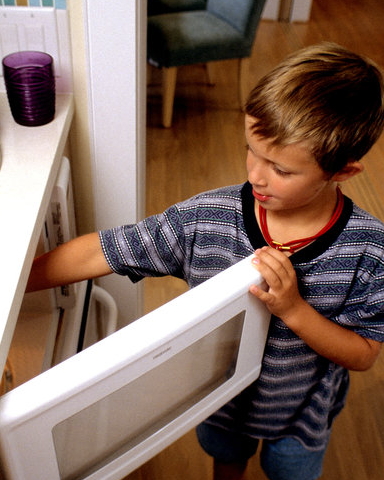 If you think about it, microwave ovens are pretty powerful tools for scientific investigation. Electromagnetic waves of a specific frequency are sent back and forth through a contained box. You can control time and the energy of the waves, and observe how they react with a variety of materials.
If you think about it, microwave ovens are pretty powerful tools for scientific investigation. Electromagnetic waves of a specific frequency are sent back and forth through a contained box. You can control time and the energy of the waves, and observe how they react with a variety of materials.
If you’ve got a microwave oven handy (and permission from your grown up to use it), here are a couple of investigations to try out.
Speed of Light
Did you know you can measure the speed of light with a large chocolate bar, a ruler, calculator, and a microwave oven? Microwaves are after all just light waves with a wavelength too big for our eyes to see. Here’s how you measure their speed.
First, if your microwave has a rotating plate, remove or disable the plate and all the parts that spin it around. You don’t want anything to move in the microwave when it is on.
Next place the chocolate bar upside down on a paper plate so that the nice smooth chocolaty surface is facing up.
Put the plate in the microwave and heat it on high for 15 seconds.
Remove the plate and look for the melted spots on the chocolate. Use the ruler to measure the distance between the close edges of two melted spots in centimeters. These two spots are where the light wave went into the chocolate bar and came back out again and is equal to half of a microwave wavelength
Use your calculator to divide that distance by 100. This is the distance in meters. Multiply that number by 2 to get the full wavelength in meters.
Look on the door or back of your microwave to find the frequency of the light waves it uses to cook your food. Most microwaves have a frequency of 2450 MHz, which are 2,450,000,000 waves per second!
Multiply the full wavelength in meters by 2,450,000,000 waves/second to get the speed of light. You should get something close to 300,000,000 meters/second!
And if chocolate (and the metric system) is not your thing you can use Peeps instead
Speaking of Peeps….
Peeps (or Marshmallows)
It used to be that you could only find Peeps at Easter time but now there are Peeps for every major holiday – even Thanksgiving. But if you can’t find them right now you can always just use regular marshmallows.
Place a few Peeps on a paper plate – it will make a sticky mess.
Microwave the Peeps for 1 minute. When do they start to puff up? Do they keep getting bigger for the whole minute?
Take the Peeps out of the microwave and dissect one with some toothpicks (it’s hot and you don’t want to burn your fingers). Is it hollow inside? Measure the Peeps before and after to see how many times bigger the microwaved peep grew. What happens to the shape, size and appearance of the Peeps as they cool down?
Peeps are made of sugar, water and air. In the oven, the microwaves heat up the water (which also heat up the air and sugar) until it turns to steam and pushes against the warm soft sugar, making bigger bubbles inside the Peep and causing it to grow in size. When it cools down the bubble shrink back down and so does the Peep.
Does it matter if you use fresh or stale Peeps? Turn microwaving Peeps into a game with Peep Jousting! Also check out this peek inside a Peep factory. What happens when you microwave other candies?
Ivory Soap
Not all soaps are created equal. Ivory soap was once marketed as “The soap the floats!” This is because Ivory soap has bubbles whipped into it. If you look carefully at the bar of soap you will notice tiny bubbles all over its surface. This causes an interesting change in the soap when you microwave it.
Place the soap on a paper plate and microwave it on high for 1 minute. What happens to the soap? It should transform from a rectangular bar into something that resembles a fluffy white cloud.
When you cook ivory soap in the microwave, two things happen. The soap itself becomes soft and the air and moisture trapped in those bubbles heats up and expands very quickly in the soft soap making a beautiful cloud-like foam.
What happens if you microwave other bars of soap? Does the same thing happen if you put the plate of Ivory soap in a hot oven?
Grapes & Boiled eggs
The folks at the New York Times investigated what happens when you microwave boiled eggs (a loud explosion!) and grapes (a glowing plasma)
Light bulbs & Chip Bags
Steve Spangler shrunk potato chip bags and lit up a light bulb with microwaves instead of electricity.
Want more?
Is it a good idea to Microwave this? video series
How the Microwave Works from Scientific American
Demystifying the Microwave from Science Friday


